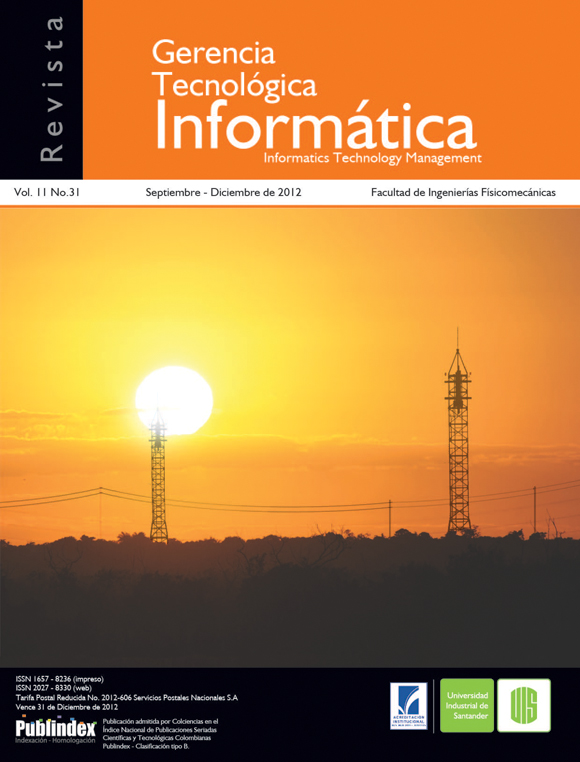Publicado 2013-02-27
Cómo citar
Resumen
RESUMEN ANALÍTICO
Este trabajo tiene como propósito plantear una técnica para presentar contenidos asociados al herbario HUC de la Universidad de Córdoba que utiliza realidad aumentada basada en la tecnología Mobile Tagging. Esta tecnología de escaneo utilizada para acceder a los contenidos alojados en el herbario virtual construido para el herbario HUC permite que desde cualquier dispositivo móvil dotado de cámara y software lector de Qr codes, códigos 2D de respuesta rápida, se obtenga información adicional del objeto observado. La técnica de herbario virtual con Mobile Tagging para el acceso a contenidos permite ampliar la realidad observada por el estudiante y por tanto el conocimiento adquirido durante las consultas realizadas en el herbario. Posterior a la construcción del herbario virtual se crearon los contenidos multimedia y se realizó la etiquetación online de ejemplares y offline de familias en el herbario HUC con el fin de implementar la tecnología Mobile Tagging. Finalmente, se realizó un cuasiexperimento que permitió evaluar los efectos de la técnica para presentar contenidos asociados al herbario HUC en el Rendimiento Académico de los estudiantes del grupo de trabajo. Se llega a la conclusión de que la técnica de herbario virtual con acceso a contenidos mediante Mobile Tagging mejora el Rendimiento Académico de los estudiantes evaluados.
PALABRAS CLAVES: Realidad Aumentada, , Mobile Tagging, QR Code, Herbario, Rendimiento Académico
AUGMENTED REALITY BASED IN MOBILE TAGGING:TECHNIQUE FOR PRESENTING CONTENTS ASSOCIATED WITH THE HERBARIUM
ANALYTICAL SUMMARY
The purpose of this Project is to suggest a technique for presenting contents, associated with the herbarium in Cordoba University that uses augmented reality technology-based Mobile Tagging. This scanning technology used to access content housed in the virtual herbarium built for the HUC allows from any mobile device equipped with a camera and reader software of QR codes, 2D codes of rapid response, obtain additional information from the object that is observed. The technique of virtual herbarium with Mobile Tagging for access to content allows you to extend the reality observed by the student and therefore the knowledge gained during the consultations in the herbarium. Subsequent to the construction of the virtual herbarium was created multimedia content and are tagging with QR code online and offline the families and species in the herbarium HUC in order to implement the technology Mobile Tagging. Finally, we performed a quasi-experiment that allowed us to assess the effects of the technique for presenting contents associated with the herbarium HUC in students' academic performance of the working group. As a conclusion the virtual herbarium technique with Mobile Tagging contents improve the academic achievement of the evaluated students.
KEYWORDS: Augmented Reality, Mobile Tagging, QR Code, Herbarium, Academic Achievement
Descargas
Referencias
- AZUMA, Ronald. A Survey of Augmented Reality (PDF). (Malibu), Ago. 1997. www.cs.unc.edu/ ~ azuma / ARpresence.pdf
- MILGRAM, Paul. A Taxonomy of Mixed Reality Visual Displays (online). (Toronto, Canadá), Dic. 1994. http://etclab.mie.utoronto.ca/people/paul_ dir/IEICE94/ieice.html
- DIVYAN, K. Mobile RIFD Security Issues (PDF). (Hirosima, Japón), Ene. 2006. http://koasas.kaist. ac.kr/bitstream/10203/23123/1/Divyan_SCIS06. pdf
- FERNÁNDEZ, Ginés. Generador e intérprete de Qr Code (PDF). (Sevilla), Dic. 2009. https://forja. rediris.es/docman/view.php/400/1004/
- SANCHEZ, I. (2010). Base de datos del Herbario CPUN de la Universidad Nacional de Cajamarca. Proyecto de investigación, Universidad Nacional de Cajamarca, Perú.
- GOMEZ HERNANDEZ, María. Xanath: Componentes visuales para la biblioteca digital de un herbario. Puebla, México, 1998. Trabajo de grado (Licenciatura en Ingeniería en Sistemas Computacionales). Universidad de las Américas Puebla. Escuela de Ingeniería. Departamento de Ingeniería en Sistemas Computacionales.
- FERNANDEZ DE PINEDO, Ignacio. Construcción de una escala de actitudes tipo Likert (PDF). (Barcelona), 2009. http://www.ceddi.uan.mx/siu/ Archivos/2009/P.P.S%20apoyos%20didacticos/ Apoyos%20General/Likert-1.pdf
- HUIDOBRO, José. Código QR. Revista Bit Digital N° 172, p. 47-49. Madrid, 2009.
- SCHMIDMAYR, Paul. What’s the Power behind 2D Barcodes? Are they the Foundation of the Revival of Print Media? En: 6th International Conference on Knowledge Management and New Media Technology. Graz, Austria: Maurer, 2008. p. 234- 242.
- CIRUELA, Sergio. Comunicándonos con las cosas. Revista electrónica Ciencia Cognitiva. p. 68-71. España, 2009.
- GOMEZ GOMEZ, Jorge. Aproximación metodológica para el diseño de actividades de aprendizaje activo soportadas en conciencia contextual. Tesis de maestría (Ingeniería Telemática). Universidad del Cauca. Facultad de Ingeniería Electrónica y Telecomunicaciones. Departamento de Telemática.
- SERRANO CASTAÑO, Carlos. Modelo Integral para un Profesional en Ingeniería. Cauca: Universidad del Cauca, 2005. 147 p.
- ROUILLARD, José. Contextual QR Codes (PDF). (Villeneuve), 2008. http://www2.lifl.fr/~rouillar/ publi/2008_Rouillard_ICCGI.pdf
